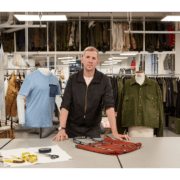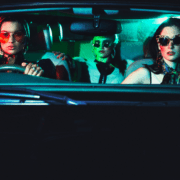Director – Patrick Taylor Debuts New Short Film “Faces” To Give A Voice To Mixed-Race People.
Meet the different faces of the mixed-race community. Film Director – Patrick Taylor – pulls down the curtain of perceptions in their latest short, “Faces”. Check out the film which is available to watch now!
Tell us a little about yourself and where you grew up?
I grew up in Stoke-on-Trent in the midlands, before moving to study at the University of the Arts London in 2013. Stoke has a proud history of creativity. It’s affectionately called ‘the Potters’ on account of its life as one of the main exports of pottery during the industrial revolution. Despite the industry’s decline in recent years, the city still harbors a large plethora of creatives. It’s ingrained in our blood.
In the context of the documentary, Stoke was largely white growing up. That’s one of the reasons I like London, it’s so big you can fall into anonymity with ease. It’s also hugely multicultural, and upon moving here, for the first time in my life I felt comfortable.
For the longest time I was the only child of colour at my school. As mentioned in the film, I wanted to be white as a result. School kids are cruel, they have no filter. I didn’t want any ammunition against me that would place me as ‘different’. I imagine it might have been the same if I’d grown up in my mother’s country (Philippines). But therein lies the unique problem that surrounds a multiracial person, where do I belong?
How has your background shaped who you are as a director?
My background has definitely helped me to understand and relate to people more, especially being mixed race, and as a result shy. This definitely helps when collaborating with others. I want people to feel welcome and to have fun.
I was fairly shy and socially awkward as a child. I spent a lot of time at home, and as a result, spent most of my time drawing, painting or making stop motion videos with the family camcorder. I was living inside my head, within the confines of my own imagination, for the most part. I think this element of alone time helped to fine tune my creativity until I finally came out of my shell.
What is the Faces 2020 documentary about and why create it?
‘Faces’ is a personal film, and I felt it important that I feature. It came at a time when I was able to recognise how comfortable I’d become in my own skin. The topic itself is largely underrepresented. Belonging to two or more cultures is so unique, that many people are unable to comprehend its anxieties. The body is inescapable, and so is the power that others have over it. It makes growing up difficult, and that’s where the majority of these issues begin for mixed race people. It’s an identity struggle that can carry forward into adulthood.
Many mixed race individuals teeter between cultures, not feeling they belong to either. Oftentimes, they choose to identify with the country of their upbringing through ease and default. Such identity issues can leave you feeling guilty and confused. “Who am I? What am I?” These questions run deep. I felt it important to explore these elements as part of the healing process, to finally close the gap on who I am, and why I am. To raise awareness of this topic.
Why choose the subject matter of the experience of mixed-race people in the U.K?
For me, I can only speak from my experience in the UK, but I understand its issues are universal, regardless of location. I think it’s particularly interesting, because the social norms have progressed so much in the past twenty years alone. For instance, racial slurs were much more widely used to describe corner shops or takeaways, and now we see far less of that.
The word ‘half-caste’ was so commonplace in the UK during my childhood, that I even identified as one. If you begin to research its meaning, you begin to understand its venom. ‘Half-caste’ takes the Latin word ‘castus’, meaning pure, and its Spanish derivative ‘casta’, meaning race. It essentially means that white is pure and that anything else is muddied.
Wherein labels have mattered so much to people such as myself, it’s important to note that with ‘Faces’, I purposely left out our subject’s heritage. Why? Because it doesn’t matter. We’re largely proud of our heritage, but we’ve had to live with people asking “where are you from?” our entire lives, that I wanted to choose otherwise. It’s an itch that needs scratching for so many. Race becomes a game. I wanted to take that power back. It’s not to say that I’m unhappy to discuss my heritage, but let’s have a sit-down meal, a game of FIFA and a walk before we discuss how my parents met…
What are the common misconceptions of being biracial?
That’s a tricky one. For me, things such as the ability to talk the language, love the food and visit every summer, when in reality I can’t speak the language, I don’t love all the food and I haven’t visited since I was twelve. Nonetheless, I’m very happy to share such a heritage, but just because I do, doesn’t mean I’m completely immersed. There are so many factors. I’d just be Filipino, or just British, otherwise.
What do you think is the future of biracial people?
As mentioned, attitudes have become far more progressive. The last UK census in 2011 showed that the mixed-race populace was the fastest-growing ethnic group in Britain amounting to 2.2% of the population in England and Wales – Mixed White/Asian 0.6%, White/black African 0.3%, White/Black Caribbean 0.8%, mixed other 0.5%. The next census takes place in 2021, in which I imagine they’ll be a huge spike. Interracial couples are more commonplace, and love becomes about love and nothing else. I think with our generation and the next, you’ll really start to see more and more. People don’t care as much as anymore, and that’s a great thing. We’re starting to judge people on their person and not their skin tone.
Check out the GUAP Arts & Culture section, to discover new art, film, and creative individuals.




![ZINO VINCI’S ‘FILTHY & DISGUSTING’EP BRINGS YOU TO THE CORE OF THE ARTIST [@ZinoVinci]](https://guap.co/wp-content/uploads/2023/10/Zino-4.jpg)




